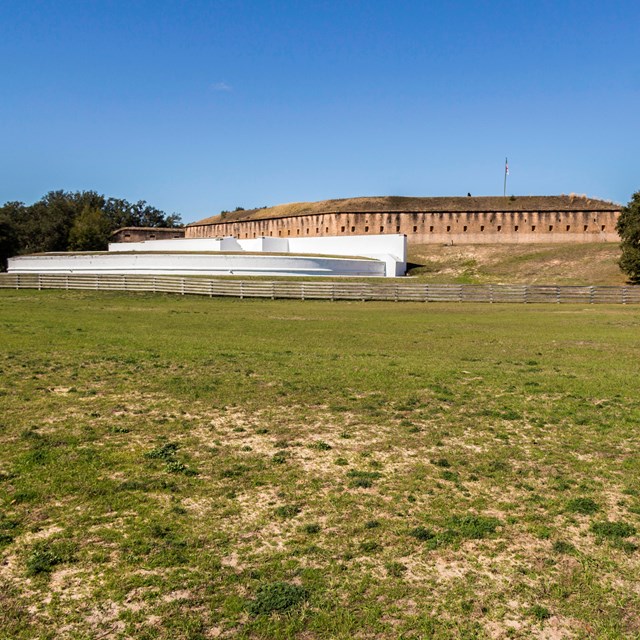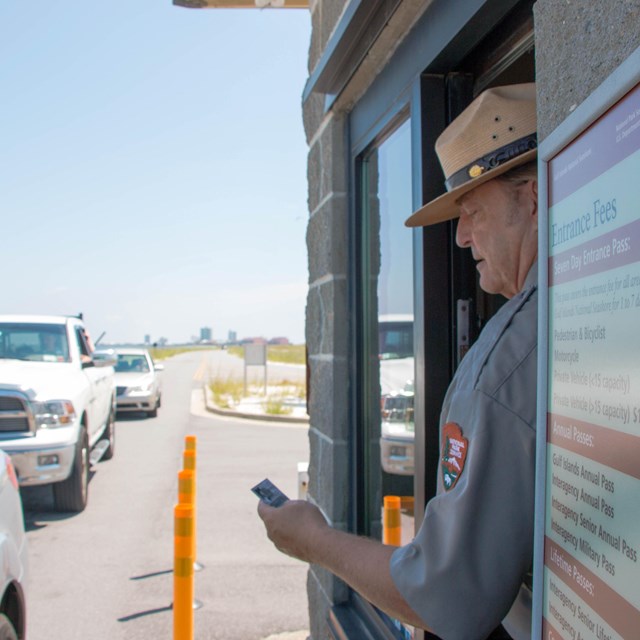
NPS/Everitt Bastion on the BluffsHigh on a bluff overlooking the entrance to Pensacola Bay, Fort Barrancas stands as a monument to the legacy of America’s early homeland defense. Built with 6 million bricks, walls 4 feet thick and 20 feet high, Fort Barrancas was completed in 1844 and remains an example of military engineering and a marvel of human ingenuity. Fort Barrancas, with the Advanced Redoubt, provided defense for the Pensacola Navy Yard. Fort Barrancas’ unique location upon elevated shoreline bluffs provided it a commanding view of the entrance to the deep harbor in Pensacola Bay. The bluff (or barrancas) overlooking the entrance to the bay was so strategic, the Army Corps of Engineers built Fort Barrancas over the ruins of other forts built by the Spanish, French, and British as early as the late 17th century.
The brick archways and vaulted ceilings stare down into the wide dry moat, allow visitors to realize the strength of this imposing structure. Built in a shape of a kite or diamond, the fort could withstand possible attack on four faces, two seaward and two landward. Assaulting infantry entering the dry moat would suffer heavy casualties from muskets and cannon fire through the opposing embrasures and loop holes in the fort walls. Hot shot furnaces improved the fort’s ability to defend the harbor from wooden vessels. Although Fort Barrancas was built to stop any foreign invasion, the only time the fort saw actual combat was during the American Civil War. After the war, Fort Barrancas continued to serve as a part of the United States’ coast defense system until 1947 when it became part of Pensacola Naval Air Station. I Fort Barrancas became part of Gulf Islands National Seashore and underwent extensive restoration which was completed by the National Park Service in 1980. Fort Barrancas has withstood not only the actions of war, but also of time and the elements. It continues to stand strong today as a monument to our early national defense, to the workers and engineers who constructed it, and to the soldiers that served within its massive walls. Federal forces moved to Fort Pickens on January 10, 1861 the same day the State of Florida seceded from the Union. Two days later, Alabama and Florida state militias occupied Fort Barrancas, Fort McRee, the Advanced Redoubt, and the Pensacola navy yard. This produced a tense stalemate in Pensacola that rivaled that at Charleston Harbor, South Carolina and Fort Sumter in the months before the Civil War began there.
Gen. Braxton Bragg took command for the Confederate Army at Pensacola in March. A strict disciplinarian, Bragg banned alcohol within 5 miles of the camps and instituted a rigid schedule of drills and fatigue duties. Each officer was expected to be ready for an intelligent discharge of all the duties of his station, and all soldiers were to devote themselves to the “acquirements of knowledge so essential to the success of the glorious cause on which we are engaged.” Drilling in the hot sun while closely laced up in heavy woolen uniforms was blamed for much sickness. Hundreds of Soldiers were also stricken by consumption, malaria and diarrhea. Action came in September with a raid on the navy yard by about 100 Federal Marines and sailors from Fort Pickens. Bragg responded on an October evening with about 1,000 men in a night attack on Santa Rosa Island, burning the camp of the 6th New York Infantry. Federal forces answered with a massive bombardment Nov. 22 and 23, heavily damaging the outer defenses of Fort Barrancas. Bragg wrote, for the number and caliber of guns and weight of metal brought into action it would rank with the heaviest bombardments in the world. Confederates abandoned Pensacola in May 1862, and Fort Barrancas saw no further combat. Visit Fort Barrancas
|
Last updated: April 2, 2020



